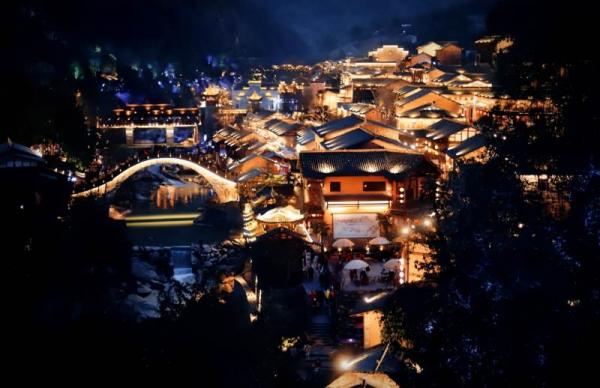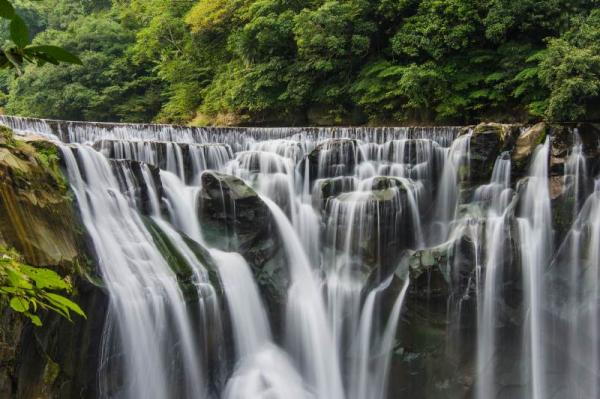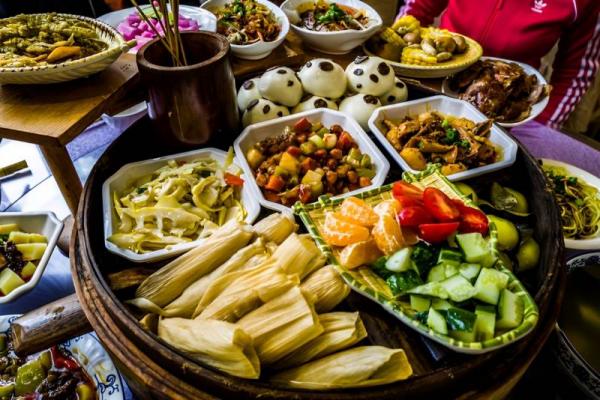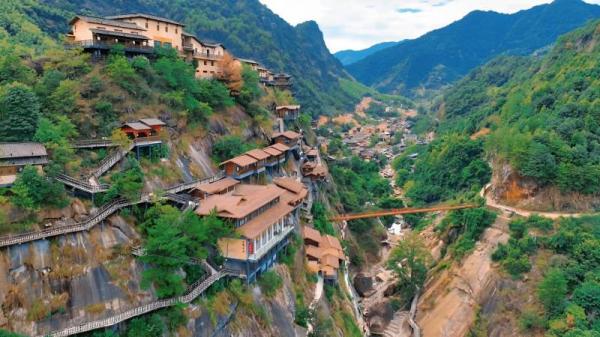Wangxian Valley: Explore the Cliffside Wonderland in Jiangxi
Wangxian Valley Facts
Why Visit Wangxian Valley
Wangxian Valley in China is a national AAAA-level scenic spot that integrates natural landscapes, unique architecture, thrilling adventures, and folk customs, which make it a must-visit attraction during your Jiangxi tours.Natural Wonders
Wangxian Valley greets visitors with rolling mountains, huge stones, and majestic waterfalls. Deep canyons lie between the peaks as if they are works of art meticulously carved by nature. With a forest coverage rate of 81%, this natural oxygen bar is home to rare plants such as Chinese yew, ginkgo, podocarpus, and the ancient pagoda tree.Unique Architecture
On the 110-meter-high cliff, there stands hanging hotels and a cliffside library, which are constructed along the contours of the mountains. Walking on the old streets, you can see ancient Jiangxi-style buildings on both sides. What’s more, Wangxian Valley houses and residences of Ming-Qing style can also be seen in this tourist spot. For instance, Yangfu Mansion, featuring a three-courtyard and two-patio structure with intricate brick, wood, and stone carvings, shows a profound artistic value.Thrilling Adventures
Wangxian Valley invites visitors to take part in exciting activities. Canyon rafting is one of the most popular water-based activities that is suitable for adventurers. Besides, walking through the cliffside glass bridge is also a good option for adventure seekers. With a width of 1 meter and length of 50 meters, the glass bridge has a vertical height of nearly 100 meters, which brings a thrilling experience when walking on it.Folk Customs and Activities
Located at the juncture of four provinces, Wangxian Valley of Jiangxi, China is a melting pot of different cultures and a fusion of folk customs and traditions. It is a happy land of temple fairs, folk activities, bonfire parties, and dragon and lion dance performances. Particularly, seasonal events and traditional festivals bring vitality to Wangxian Valley Town.

Wangxian Valley History
The history of Wangxian Valley can be dated back to the Three Kingdoms period preceded by the Eastern Han dynasty (25-220). According to historical materials such as the Lingshan Chronicles of the Ming Dynasty, the town got its name from the legend of the recluse Hu Zhao (the teacher of Sima Yi).
Hu Zhao moved south with his family to Lingshan in Shangrao after refusing Cao Cao's recruitment, and he started to practice Taoism in solitude. The villagers respected Hu Zhao for his profound Taoist practices and regarded him as the founder of Lingshan Taoism, hence naming the place "Wangxian" (which means "looking for immortals").
What to Do in Wangxian Valley
Stepping into Wangxian Valley Town is like entering a magical world of fairy tales. Below are the top things to do in Wangxian Valley.Marvel at the Cascading Waterfalls
Wangxian Valley has the largest artificial waterfall group in the country. Though not naturally formed, each waterfall has been meticulously designed to present a hierarchical beauty. Among these waterfalls, the Three-Tiered Waterfall is the most famous one, with a drop of over 100 meters, creating a spectacular view. Standing under the waterfall, you’ll marvel at its magnificence and power when you see it cascading down from the cliff with a water flow in various forms.
>> Related Reading: 10 most beautiful waterfalls in China For waterfall buffs

Hiking along the Cliff Walk
Wangxian Valley is a paradise in China for hikers. Every step of hiking along the cliff walk or trekking across the mysterious valley is an intimacy with nature. When you set foot on the trails, you’ll find it not steep but rather full of fun and challenges. The scenery along the way is like an exhibition exquisitely arranged by nature: wildflowers are blossoming, and butterflies are dancing gracefully. The remote mountains resemble a beautiful ink painting when illuminated by the sunshine.>> Related Reading: 6 Best Hiking Trails in ChinaEmbark on an Exhilarating Canyon Rafting
Canyon rafting in Wangxian Valley is an experience that cannot be missed. Start your journey along the 2.8-kilometer (1.7-mile) rafting track with a drop of 185 meters (607 feet), during which you’ll travel through three bays, pools, and waterfalls. As you ride the raft down the winding river, you'll be surrounded by sparkling water and majestic trees lining the riverbanks.Admire the Ancient Architecture
The ancient Chinese architecture has witnessed the past of Wangxiangu. Take a stroll along the winding alleys, you’ll find most residences have retained the style of traditional residences in northeastern Jiangxi with gray bricks, black tiles, and horse-head walls. Besides, Yangfu Mansion’s Ming-Qing style structure and intricate carvings also attract a lot. Additionally, the wooden-structured Hu's Ancestral Hall featuring upturned eaves and bracket sets also displays exquisite craftsmanship.Immerse in the Breathtaking Night Views
When night falls, Wangxian Valley is illuminated by dazzling lights, turning into a magnificent nightscape oil painting without a frame. You can set out on a night tour in this wonderland, where mountains play hide-and-seek with the moonlight, and the streams gently hum the melody of the night. Pavilions and towers are orderly scattered along the streams, providing a great place for tourists to relax and enjoy the extreme beauty of the night.Experience Folk Culture and Customs
Folk culture performances bring vitality and dynamism to Wangxian Valley. From 3:00 PM to 7:00 PM, various performances will be staged on various stages throughout the scenic spot. Never miss the storytelling performances and Han-style wedding performances, through which you can feel the essence of traditional Chinese culture.Take Beautiful Pictures in Hanfu
Wangxian Valley is an excellent place for taking photos of traditional Chinese elements: old streets, ancient buildings, and light-decorated bridges. Remember to wear traditional Han Chinese clothing (Hanfu) or rent costumes from local shops. Baihe Cliff, Baige Bridge, Qingyun Bridge, and Lanyue Bridge are popular sites for taking photos of Wangxian Valley Town, as they offer stunning views both day and night.Best Time to Visit Wangxian Valley
Wangxian Valley is open all year round, and you can plan a trip to Wangxian Valley Town in any season. More specifically, the annual average temperature is 17.9°C, and there are about 250 frost-free days, making it pleasant for traveling. Spring greets visitors with cherry blossoms and rape flowers, and summer makes it an ideal place for summer retreats. You can visit the waterfall group, go canyon rafting, or just walk along the streams to enrich your travel experience.As autumn approaches, the rolling mountains are blanketed with red leaves, and the sea of clouds appears from time to time. Winter is the best season to enjoy the tranquility of Wangxian Valley Town and the snow-covered landscape when it snows.

Must-try Food in Wangxian Valley
When it comes to cuisine, Wangxian Valley never disappoints visitors. There is a Baiwei Food Street, where you can try a wide range of delicious food, including Wuyan Fruit, Wangxian Donggua Tea, and Kudzu Root Crisp. Besides, local restaurants offer mouthwatering special dishes, such as Wangxian Smoked Pork with Crispy Bamboo Shoots, Wangxian Fried Tofu, Sweet Potato Noodles with Beef Brisket, and Farmhouse-style Braised Pork with Preserved Vegetables.How to Tour Wangxian Valley
In general, 4 to 5 hours is enough for touring Wangxian Valley, and below is a popular sightseeing route.
Tourist Center - Qingyun Bridge - Waterfall Group - Mijin Pass - Yanpu Square - Baiwei Food Street - Yangfu Square - Hu's Ancestral Hall (Han-style wedding performances at 15:00-15:30) - Workshop Street - Sanshen Temple - Bonfire Square - Baihe Cliff (lights show at 18:00) - Zuixian Street - Lanyue Bridge - Baige Bridge - Changkong Bridge - Rafting Square - Stage Square (bonfire party at 20:00) - Exit